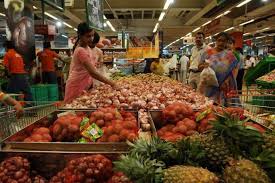CPI inflation falls in
September; will RBI act?
 New Delhi: Inflation based on the Consumer Price Index (CPI) has decelerated to
a record low since the index was launched in January 2012, even as factory
output growth continues to be flat, increasing pressure on the central bank to
cut interest rates earlier than it would have wanted to. CPI-based inflation
eased for the second month in a row to 6.46% in September, compared with a
downward revised 7.73% a month ago, driven by lower price increases in food and
fuel items.
New Delhi: Inflation based on the Consumer Price Index (CPI) has decelerated to
a record low since the index was launched in January 2012, even as factory
output growth continues to be flat, increasing pressure on the central bank to
cut interest rates earlier than it would have wanted to. CPI-based inflation
eased for the second month in a row to 6.46% in September, compared with a
downward revised 7.73% a month ago, driven by lower price increases in food and
fuel items.
A Reuters
poll of 28 economists had predicted retail price inflation in September at
7.2%. The Index of Industrial Production (IIP) rose 0.4% in August, unchanged
from July and down from 3.94% in June, data released on Friday showed. JPMorgan
cut its India gross domestic product (GDP) growth projection for 2014-15 to
5.1% from 5.3% after the factory output data was released. “IP (industrial
production) debacle is the straw that breaks the camel’s back,” JPMorgan said
in its 10 October report.

India’s
GDP grew 5.7% in the three months ended 30 June, the fastest pace in
two-and-a-half years, and had sparked optimism that Asia’s third largest
economy was set for a rebound after two years of sub-5% GDP expansion. Weak
factory output growth in the past two months has dampened some of the optimism
and enthusiasm that followed the ascent of the Bharatiya Janata Party to power
with a decisive mandate in the April-May general election. In the year to next
March, the government expects the economy to grow 5.8%, and is counting on a
revival of investments and big-ticket infrastructure projects.
The
Reserve Bank of India (RBI) left its policy rates unchanged last month, citing
high retail inflation and reiterated its resolve to bring down consumer price
inflation to 6% by January 2016.
The
continuing decline in crude oil prices may cause a further fall in retail
inflation. The ministry of petroleum and natural gas said in a statement on
Monday that the international crude oil price of Indian basket as computed by
the petroleum planning and analysis cell was $88.23 per barrel on 10 October,
compared with $90.50 per barrel on the previous publishing day of 9 October.
Slower
growth and the fall in oil and commodity prices increase the chance for RBI to
attain its challenging 6% consumer price inflation target by January 2016,
JPMorgan said.
The
International Monetary Fund last week said that monetary normalization in India
should proceed gradually, given the high level of inflation in the country. “In
India, with recent monetary tightening, disinflation should continue, but
inflation overall will remain high at 7.8% in 2014, declining slightly to 7.5% in
2015,” IMF said in its report.
The
inflation moderation is on the back of a significant statistical base effect,
which should continue till November, said Rupa Rege Nitsure, chief economist at
Bank of Baroda and a member of the RBI panel on monetary policy framework. “RBI
will likely be looking for a durable reduction in inflation and will monitor
the inflation trajectory for four-five months after December before taking a
call on cutting rates.
As such, a
prolonged pause can be expected from the RBI,” she said. photo Retail food
inflation fell significantly to 7.67% in September from 9.35% a month ago.
While the price rise in vegetables and cereals decelerated in September
compared with August, prices of pulses rose at a faster rate. Encouragingly,
core inflation, or non-food and non-fuel price inflation, slowed to 5.9% from
6.9% in August, suggesting that demand-driven price pressures are weakening.
Advance
estimates for food production indicate substantial shortfalls in production of
various kharif crops in 2014 as compared with 2013, according to Aditi Nayar,
senior economist at Icra Ltd; these include pulses (14%), coarse cereals (14%)
and oilseeds (12%), all of which point to the risk of hardening food prices in
the near term. In a working paper on food inflation published on its website,
RBI said empirical evidence shows that increasing real rural wages have played
the most dominant role in determination of overall food inflation in India in
the long-run. “Though statistically significant, the long-run impact of hikes
in MSP (minimum support price) of food crops, namely, rice and wheat and input
cost inflation (except wages) on food inflation were not as over-bearing as was
generally perceived.

Similarly,
the long-run impact of protein expenditure on food inflation, though
significant statistically, was found to be weak,” it said. MSP is the price at
which the government sources foodgrains from farmers for the public
distribution system. RBI also ruled out any significant impact of the Mahatma
Gandhi National Rural Employment Guarantee Scheme (MGNREGS) on food inflation.
MGNREGS
provides at least 100 days of manual labour every year to one member of every
rural family.
The paper
concludes that since the increase in real wages has the largest influence in
driving food inflation, there is a need to raise agricultural productivity
through enhanced investments and improved technology, in line with the increase
in real wages to reduce food price pressures.
“Reducing
the supply-demand gap in agriculture production in the long-run and improving
supply logistics will be of utmost importance for moderating food price
pressures and for sustaining the pace of economic activity by securing adequate
food availability at reasonable prices,” it added. Anup Roy in Mumbai contributed
to this story.
RANJAY KUMAR,
PGDM 2ND
YEAR,
SOURCE- MINT
I feel this is a bed for india it is not fulfill in this month.